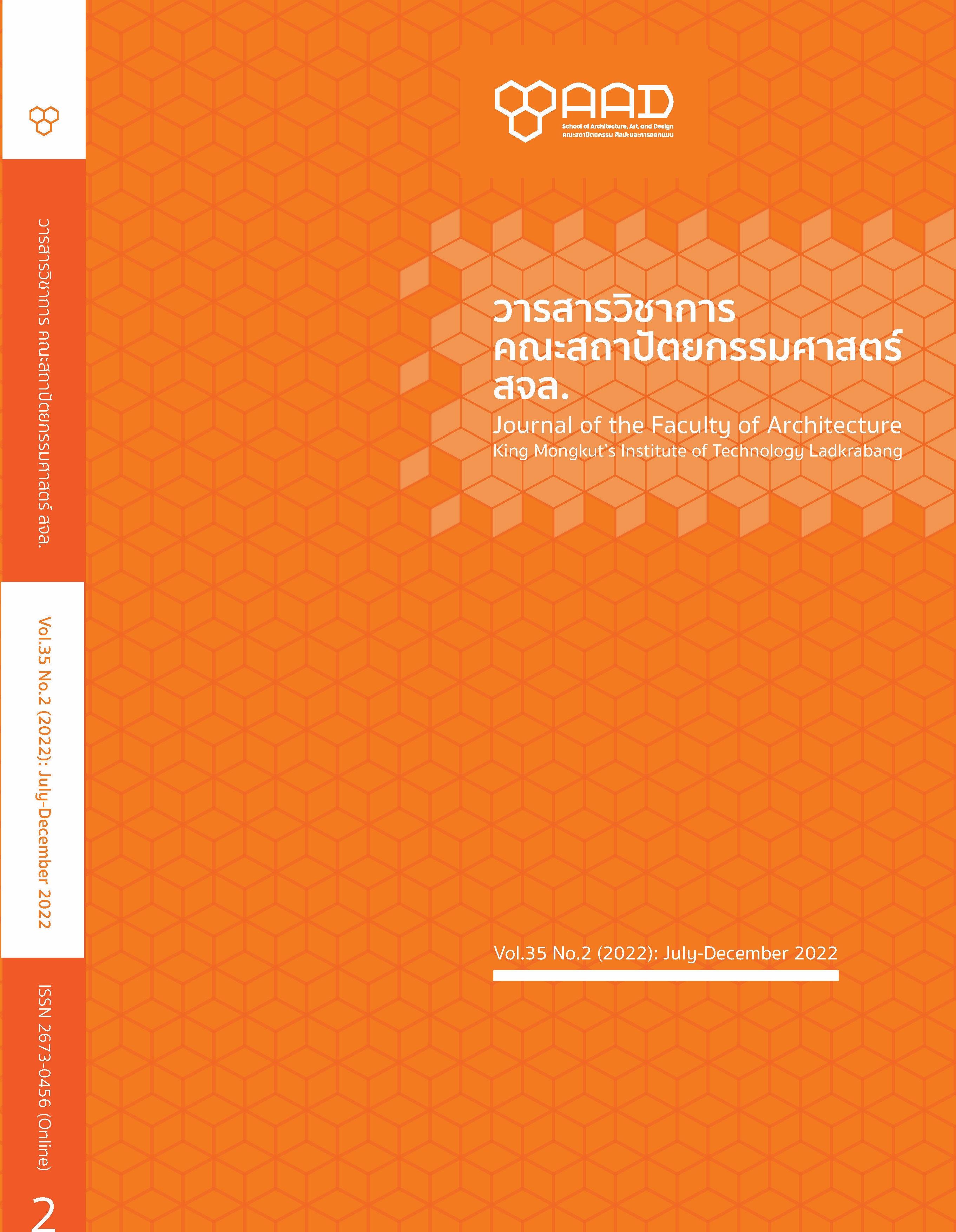Improving low-income Housing in the Ladphrao Canal Communities by Universal Design Approach
Main Article Content
Abstract
This research aims to survey, collect and analyse data about the problems of living condition of the elderly and disabled people who live in the Baan Mankong community along Ladphrao canal and propose solutions for housing design development and prepare a prototype for improving housing to be convenient and meet the universal design guidelines and conclude and prepare information for dissemination to the community for future use. The study selects a group sample by using purposive sampling from 16 households. The number of people who encountered from housing facility, particularly, elderly and disabled people as 41 cases. The research found that the first group is muscle weakness with the need to use assistive devices, another group is who have disabilities or bedridden patients who are unable to move or walk on their own. Also, they need to use wheelchairs to move. Furthermore, a result shows that 2 residential areas that need major improvement, the first is a bathroom need a piece of equipment such as handrail to support when using the bathroom and replace the floor to non-slip surface together with replace a plastic curtain instead of bathroom door due to can easily to move inside. Moreover, another area that has a problem is the entrance of the house. It was found that the not width enough for a wheelchair to enter (the dimension only 80centimeters) and also the step floor between inside and outside quite different (the height between 30-50 centimeters) that difficult for elderly and disabled people to enter or exit. Not only the step entrance and size of the door entry, but also need to add a ramp for them to enter and use a handrail to support them during the move into the house as well. The cost for renovating depend on the condition of the problem, such as installing handrails in the bathroom area is between 2,000 – 4,500 baht and For the construction of a ramp, it is between 3,500 - 12,000 baht, depending on the area and material conditions. The design of housing for low-income communities in the future should stipulate the design conditions to be comprehensive and flexible to support the use of the elderly and the disabled effectively under a limited budget. In addition, encouraging community participation in learning the universal design process, Including the development of community technicians will support problems solving and improve suitable housing for all in the future.
Article Details

This work is licensed under a Creative Commons Attribution-NonCommercial-NoDerivatives 4.0 International License.
This work is licensed under a Creative Commons Attribution-NonCommercial-ShareAlike 4.0 International License.
Copyright Transfer Statement
The copyright of this article is transferred to Journal of The Faculty of Architecture King Mongkut's Institute of Technology Ladkrabang with effect if and when the article is accepted for publication. The copyright transfer covers the exclusive right to reproduce and distribute the article, including reprints, translations, photographic reproductions, electronic form (offline, online) or any other reproductions of similar nature.
The author warrants that this contribution is original and that he/she has full power to make this grant. The author signs for and accepts responsibility for releasing this material on behalf of any and all co-authors.
References
กนกอร ทองกลึง. (2560). การศึกษาปัจจัยสภาพแวดล้อมที่อยู่อาศัยเพื่อลดความเสี่ยงต่อการหกล้มในผู้สูงอายุ: กรณีศึกษา ชุมชนหัวตะเข้ เขตลาดกระบัง จังหวัดกรุงเทพมหานคร. Veridian E-Journal. 10(2), 2909-2921.
กระทรวงการพัฒนาสังคมและความมั่นคงของมนุษย์. (2553). พระราชบัญญัติผู้สูงอายุ พ.ศ. 2546. กรุงเทพมหานคร: เทพเพ็ญวานิสย์.
จิราพร เกศพิชญวัฒนา และภัทรพร คงบุญ. (2563). โครงการศึกษานโยบายและการดำเนินงานการป้องกันการหกล้มในผู้สูงอายุในประเทศไทย. เข้าถึงได้จาก: https://thaitgri.org/?wpdmpro=โครงการการศึกษานโยบายและการดำเนินงานการป้องกันหกล้มในผู้สูงอายุในประเทศไทย.
ธัญญรัตน์ อโนทัยสินทวี. (2557). การทบทวนวรรณกรรมอย่างเป็นระบบเรื่องมาตรการการป้องกันการพลัดตกหกล้มในผู้สูงอายุ นนทบุรี โครงการประเมินเทคโนโลยีและนโยบายด้านสุขภาพ. เข้าถึงได้จาก: https://thaitgri.org/?p=36704.
ไตรรัตน์ จารุทัศน์. (2558). คู่มือการออกแบบเพื่อทุกคน. พิมพ์ครั้งที่2. กรุงเทพฯ: กรมส่งเสริมและพัฒนาคุณภาพชีวิตคนพิการ กระทรวงการพัฒนาสังคมและความมั่นคงของมนุษย์.
นพดล วิวัฒน์กมลวัฒน์, อัฏฐมา บุญปาลิต และนุชนภางค์ แก้วนิล. (2560). การศึกษาปัจจัยที่ส่งผลต่อการมีอายุยืนยาวเพื่อการออกแบบที่พักผู้สูงวัย. Veridian E-Journal. 10(3), 2763-2774.
นพพันธุ์ ทองเกลี้ยง. (2545). กระบวนการออกแบบที่อยู่อาศัยแบบมีส่วนร่วมของชุมชนไบเล่ย์-หลังจวนฯ จังหวัดนครราชสีมา. (วิทยานิพนธ์มหาบัณฑิต สาขาสถาปัตยกรรมศาสตร์ (เคหการ) คณะสถาปัตยกรรมศาสตร์, จุฬาลงกรณ์มหาวิทยาลัย).
นรินทร์ชัย พัฒนพงศา. (2547). การมีส่วนร่วม: หลักการพื้นฐาน เทคนิค และกรณีตัวอย่าง. เชียงใหม่: สิริลักษณ์การพิมพ์.
พิมวรินทร์ ลิ้มสุขสันต์. (2551). ปัจจัยทำนายการพลัดตกหกล้มของผู้สูงอายุ. (วิทยานิพนธ์ปริญญาพยาบาลศาสตรมหาบัณฑิต สาขาวิชาการพยาบาลเวชปฏิบัติครอบครัว บัณฑิตวิทยาลัย, มหาวิทยาลัยธรรมศาสตร์).
มหาวิทยาลัยมหิดล. (2562). ประเทศไทยกับสังคมผู้สูงอายุ. เข้าถึงได้จาก: https://il.mahidol.ac.th/th/i-Learning-Clinic/general-articles/ประเทศไทยกับสังคมผู้สูงอายุ.
สถาบันพัฒนาองค์กรชุมชน. (2557). “โครงการบ้านมั่นคง”การพัฒนาที่อยู่อาศัยโดยองค์กรชุมชนและท้องถิ่น. เข้าถึงได้จาก: https://ref.codi.or.th/attachments/article/28/Project_Guide%20_111158.pdf.
สถาบันพัฒนาองค์กรชุมชน. (2558). การพัฒนาที่อยู่อาศัยชุมชนริมคลอง. เข้าถึงได้จาก: https://web.codi.or.th/development_project/20190321-126.
สถาบันสิรินธรเพื่อการฟื้นฟูสมรรถภาพทางการแพทย์แห่งชาติ. (2557). คู่มือสำหรับประชาชนในการฟื้นฟูสมรรถภาพทางการแพทย์ขั้นพื้นฐานสำหรับคนพิการทางการเคลื่อนไหว. เข้าถึงได้จาก: http://www.snmri.go.th/wpcontent/uploads/2019/11/bookCBR_rehab59n.pdf.
สำนักงานกองทุนสนับสนุนการสร้างเสริมสุขภาพ. (2557). คู่มือบ้านใจดี บ้านที่ออกแบบเพื่อทุกคน. เข้าถึงได้จาก: http://www.thaihealth.or.th/Books/39/คู่มือบ้านใจดี+บ้านที่ออกแบบเพื่อทุกคน(Universal+Design+Home).html.
สำนักงานคณะกรรมการส่งเสริมวิทยาศาสตร์ วิจัยและนวัตกรรม. (2564). สังคมผู้สูงอายุ การเตรียมความพร้อมและรับมือกับสังคมผู้สูงอายุในประเทศไทย. เข้าถึงได้จาก: https://researchcafe.org/aging-society.
อนงค์ ดิษฐสังข์, นรีมาลย์ นีละไพจิตร และพัชระกรพจน์ ศรีประสาร. (2558). อุบัติการณ์และปัจจัยการเกิดการพลัดตกหกล้มที่บ้านของผู้ป่วยภายหลังออกจากโรงพยาบาล. วารสารพยาบาลสาธารณสุข. 29(3), 78-89.
Story, M., Mueller, J., & Mace, R. (1998). The University Design file: Designing for people of all ages and abilities. (Revised edition). State University, NC: Center for Universal Design.
University of Cambridge, Engineering Design Centre. (2015). What is inclusive design?. Retrieved From: https://www.Inclusivedesigntoolkit.com/whatis/whatis.html.


